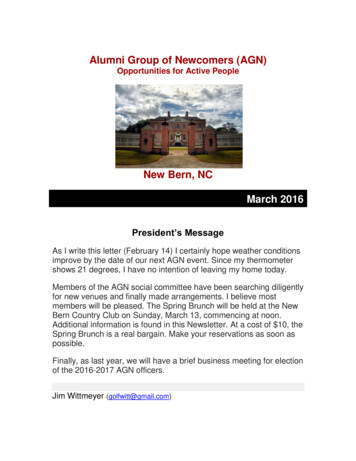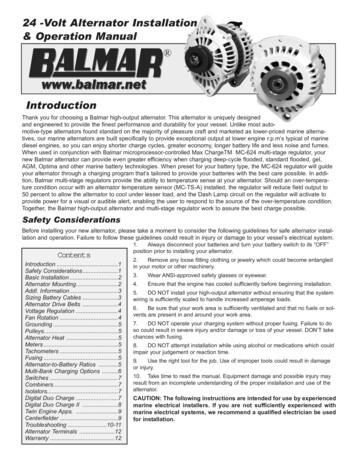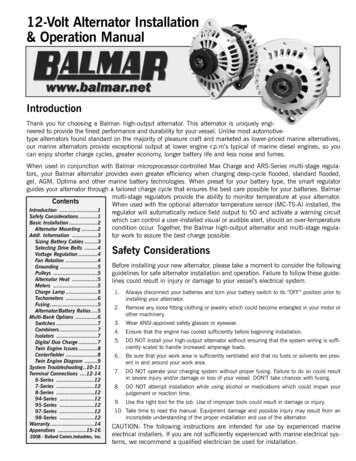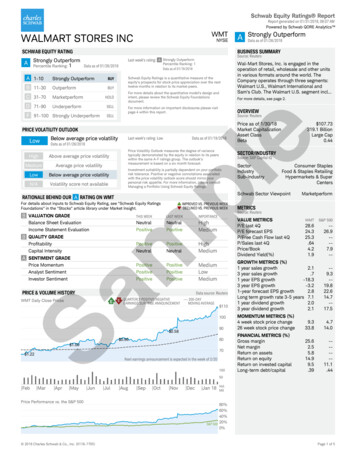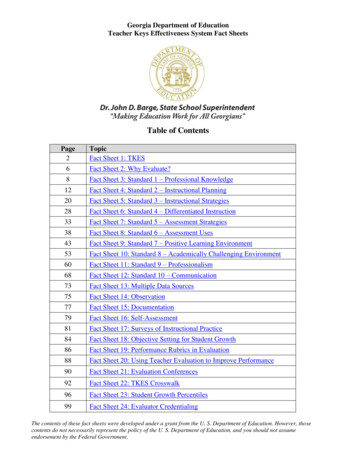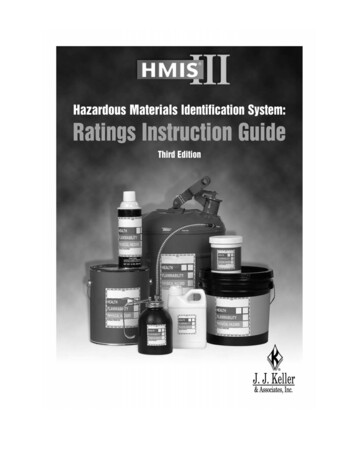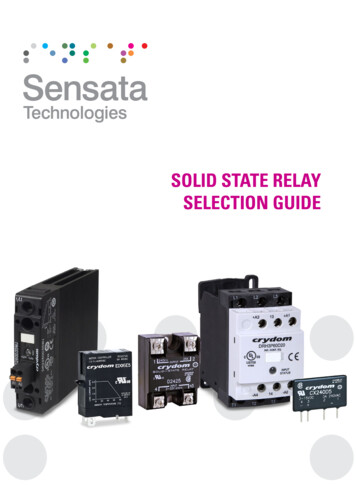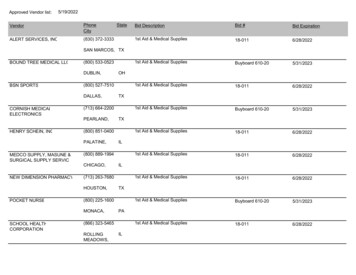
Transcription
Application Guidance Notes: Technical Information from Cummins Generator TechnologiesAGN 013 - Alternator Ratings and OverloadALTERNATOR RATINGSAC synchronous generator (alternator) ratings are specified in accordance with national andinternational Standards (IEC 60034-22: AC generators for reciprocating internal combustion(RIC) engine driven generating sets). There are two types of rating that are specified, BasicContinuous Rating (BR) and Peak Continuous Rating (PR).Basic Continuous Rating (BR)Also referred to as Maximum Continuous Rating, Continuous Running Duty - Duty type S1(IEC 60034-1) or Continuous Duty (NEMA MG1-32). The alternator will have a maximumcontinuous rating at which the machine may be operated for an unlimited number of hours peryear, while complying with the requirements of the appropriate standards.For industrial use alternators, three Base Continuous Rating levels are offered, based ontemperature rise limits and a standards ambient temperature of 40 C: Class “H” (125 C/40 C)Class “F” (105 C/40 C)Class “B” (80 C/40 C)Peak Continuous Rating (PR)This discrete constant loads rating equates to a Duty with discrete constant loads - Duty typeS10 in IEC 60034-1 or Standby Rating in NEMA MG1-32. Commonly known as the PeakStandby Rating, this rating level allows the permissible alternator temperature rise to increaseby a specified amount according to its insulation system thermal classification. For aninsulation system with thermal classification ‘H’, the total temperature may be increased by25ºC for alternator ratings of 5MVA. The result is an increased rating at the expense ofreducing the lifetime of the alternator by between 2 to 6 times of the base continuous rating.AGN 013 ISSUE C/1/10
For industrial use alternators, two Peak Standby Rating levels are offered, based ontemperature rise limits and ambient temperatures that provide a total temperature 10 C abovethe total temperature limit for the insulation system. For low voltage alternators: Class “H” (150 C/40 C)Class “H” (163 C/27 C)Declaration of Duty – Duty Types.To determine the correct size of alternator for a particular application, it is important to knowthe characteristics of the loads to be applied, along with the sequence and duration of eachload. IEC 60034-1 effectively guides a declaration of duty and offers Duty Types S1 to S10,to describe the cyclic duration of the loads to be applied:Continuous running duty – Duty type S1Short-time duty – Duty type S2Intermittent periodic duty – Duty type S3Intermittent periodic duty with starting – Duty type S4Intermittent periodic duty with electric braking – Duty type S5Continuous operation periodic duty – Duty type S6Continuous operation periodic duty with electric braking – Duty type S7Continuous operation periodic duty with related load/speed changes – Duty type S8Duty with non-periodic load and speed variations – Duty type S9Duty with discrete constant loads – Duty type S10To simplify alternator selection for the many and various load applications, Alternatormanufacturers including Cummins Generator Technologies use two Duty Types, S1 and S10:Duty Type S1 – Continuous running duty – Base Continuous Ratings are used for thistype of duty:Definition: Operation at a constant load maintained for sufficient time to allowthe machine to reach thermal equilibrium.Duty Type S10 – Duty with discrete constant loads – this type of duty is defined forStandby application:Definition: A duty consisting of a specific number of discrete values of load (orequivalent loading) and if applicable, speed, each load/speed combinationbeing maintained for sufficient time to allow the machine to reach thermalequilibrium.Clarification of Relative Thermal Life Expectancy or TL Factor.Factor TL for the relative thermal life expectancy of the insulation system is an importantintegral part of the rating class. The exact value for the factor TL is marked on the rating plate.ISO 8528-1 refers to Emergency Standby Power (ESP) and Limited Time Prime (LTP) ratingsand accepts a reduction in life for the Generating Set.‘The limited time running power is the maximum power which a generating set is capable ofdelivering for up to 500h per year of which a maximum of 300h is continuous .it isaccepted that the operation at this rating will affect the life of the generating set’AGN 013 ISSUE C/2/10
Peak Continuous Rating (PR) – also referred to as Stand-By – when offered by CGT, takesinto account the fact that this introduces a reduction in service life and so does need to bequalified with a TL factor.Based upon the above described duty cycle, a TL factor of 0.844 is advised as beingappropriate for the CGT range of alternators when they’re offered for a PR rating. This T Lfactor advises that the life expectancy of the ac generator will be reduced to 84.4% of the lifeexpectancy of that same ac generator being operated at the published BR Class ‘H’ rating.Example:Consider an alternator with a BR Class ‘H’ rating of 200kVA. This same alternator has apublished PR rating of 212kVA. If operated at the PR rating for 500h per year, the theoreticallife expectancy of the alternator will be reduced to 84.4% when compared with operation at theBR rating and a life expectancy of 100% is theoretically expected.Thermal Classification of the Insulation System and the Limit of Temperature Rise.Low Voltage (LV) alternators.The insulation system used on STAMFORD and AvK Low Voltage (LV) alternators has athermal classification ‘H’ (180ºC). The ‘half life expectancy’ of a Class ‘H’ insulation systemoperated continuously at a temperature of 180ºC is some 20,000 hours. Although this doesnot mean that the insulation system will fail after 20,000 hours.For a Class ‘H’ insulation system, the limit of temperature rise by the resistance method for amachine indirectly cooled by air, is 125K for the alternator’s armature (Stator) and dc field(Rotor) windings. For Classes ‘F’ and ‘B’, the limit of temperature rise is 105K and 80Krespectively for the above windings.The LV alternator can be operated at lower temperature rise limits for the alternative thermalclassifications ‘F’ or ‘B’, with increased ‘half life expectancy’ of 120,000 hours and 640,000hours respectively.Medium Voltage (MV) and High Voltage (HV) alternators.The insulation system used on STAMFORD and AvK Medium Voltage (MV) and High Voltage(HV) alternators has a thermal classification ‘F’ (155ºC). The ‘half life expectancy’ of a Class‘F’ insulation system operated continuously at a temperature of 155ºC is some 20,000 hours.Although this does not mean that the insulation system will fail after 20,000 hours.For a Class ‘F’ insulation system, the limit of temperature rise by the resistance method for amachine indirectly cooled by air, is 105K for the alternator’s armature (Stator) and dc field(Rotor) windings. For Class ‘B’, the limit of temperature rise is 80K for the above windings.The MV/HV alternator can be operated at the lower temperature rise limit for the alternativethermal classifications ‘B’, with increased ‘half life expectancy’ of 120,000 hours.Operating conditions.AC synchronous generators are designed to operate within the following operating siteconditions in accordance with IEC 60034-1.Altitude: The height above sea level does not exceed 1000m.AGN 013 ISSUE C/3/10
Ambient temperature: The temperature of the air at the operating site does not exceed40ºC for industrial applications. The minimum temperature at the operating site is nolower than -15ºC. Should an ambient temperature lower than -15ºC be expected, thecustomer shall specify the minimum ambient temperature and whether it applies onlyduring transport and storage or also, after installation and so, a part of operationalconditions.Adjustments to limits of temperature rise and of total temperature to take account ofoperating conditions.If the specified or resulting maximum ambient temperature is between 40ºC and 60ºC, thelimits of temperature rise shall be reduced by the amount by which the ambient temperatureexceeds 40ºC. This is achieved by reducing the Base Continuous Rating. Refer to AGN012Environmental Rating Factors.If the specified or resulting maximum ambient temperature exceeds 60ºC or is less than 0ºCthen the requirements must be referred by email to applications@cummins.com.If the specified or resulting maximum ambient temperature is between 0ºC and 40ºC, anincrease in the Base Continuous Rating may be made with the customer’s prior agreement attime of order. The increase in the temperature rise shall not exceed the amount by which theambient temperature is less than 40ºC, with a maximum of 30 K. Refer to AGN012Environmental Rating Factors.Altitude rating adjustment to take account of operating conditions.If the machine is to operate at an altitude exceeding 1000 meters above sea level, refer toAGN012 Environmental Rating Factors.Underwriters Laboratories (UL) Compliance.The insulation system used on alternators manufactured by Cummins Generator Technologiesis a class ‘H’ system for LV and a Class F system for MV and HV, as specified and describedby UNDERWRITERS LABORATORIES of the USA.U.L. have established operating temperatures and associated life expectancy levels for all theelectrical insulation materials available and group these materials into the various classesfamiliar to all those involved with electrical equipment.When considering the aspects that govern the expected life of an alternator, the thermal ratingis important, but so many other factors need to be taken into account. These include anyatmospheric contamination that could affect the insulation life and vibration levels that candamage bearings. Also, component assemblies and the characteristics of the electricalequipment being supplied. If the application of this equipment has large, or repetitive, impactloads, such as motor starting or transformer energising, or consists of non-linear loads andtherefore high harmonic levels are present, the overall life expectancy of the alternator will beaffected.Duty Cycle: ISO 8528.Internationally recognised terminology for Generating Set duty cycle definitions are relatedthermal ratings are included in ISO 8528. There follows; extracts taken from the ISO 8528engineering standards, for engine driven power generation equipment packages.AGN 013 ISSUE C/4/10
ISO 8528 consists of the following parts under the general title: Reciporcating InternalCombustion Engine driven Alternating Current Generator Sets: Part 1 : Application, ratings and performancePart 2 : EnginePart 3 : Alternating Current generators for generating setsPart 4 : Control gear and SwitchgearPart 5 : Generating SetsPart 6 : Test MethodsPart 7 : Technical declarations for specification and designPart 8 : Requirements and tests for low-power generating setsPart 9 : Measurement and evaluation of mechanical vibrationsPart 10 : Measurement of airborne noise by the enveloping surface methodPart 11 : Rotary uninteruptible power systems – Performance requirements and testmethodsPart 12 : Emergency power supply to safety servicesThe following table summaries the rating definitions in ISO8528-3 and IEC 60034-1 for theAlternator and ISO 8528-1 for the Generating Set:OVERLOADIf an alternator is operated above its designed Base Continuous Rating, the operatingtemperatures will increase to a level that will degrade and so, shorten the life of, the woundcomponents of the insulation system.AGN 013 ISSUE C/5/10
For a fixed percentage overload, the rate at which the operating temperatures increase is aproduct of the alternator’s Thermal Time Constant. This thermal time constant factor varies inproportion to:1. The physical mass of the wound components, which in turn affects the rate of thermalrise. For example; larger alternators up to 300kVA cope better than small alternatorswith outputs around 50kVA.2. The percentage level of overload above the alternator’s designed Class ‘H’ rating.3. The duration of the overload condition.4. The operating temperature of the wound components just before the overload conditionbegins.5. The ambient temperature during the overload condition.An alternator’s ability to cope with an overload condition is described by the Thermal Life [TL]factor ascribed to each alternator design.Alternators manufactured by Cummins Generator Technologies are designed to comply withall appropriate National and International Standards concerned with the performance andcapability of rotating electrical machines. Some of these Standards have been in existencefor many years and may no longer represent current power engineering practice, generatingindustry trends, or Generating Set customer’s expectations for Generating Sets thatincorporate modern technology diesel engines and alternators.An example of an ‘Old’ Standard is BS 5000pt3, and the section that refers to “10% overloadfor One hour in twelve”. This requirement is often quoted, but the following part of the samesection is often forgotten or ignored. The Standard qualifies this 10% Overload for 1 hour in12, as a condition that will result in winding over-temperature condition that will shorten the lifeof the insulation system and a condition that is only allowable in an ambient temperature notexceeding 27C.Because of misunderstandings arising around the many and varied national standards,including the “10% overload for 1hour in 12” with no clarification of the conditions, a new global,International Standard specific for Generating Sets has been written under the guidance ofISO and numbered ISO 8528.Refer to the ISO 8528 comment later in this guidance note.Occasional excess current and maximum momentary overloads.IEC 60034-1 states that an alternator must be capable of withstanding occasional excesscurrent equal to 1.5 times the rated current for not less than 30 seconds, for rated outputs notexceeding 1200MVA.The maximum momentary overload specified in NEMA MG1-32 is that a synchronous acgenerator with a synchronous speed less than or equal to 1800rpm, shall be capable ofcarrying a 1 minute overload at 150% of normal rated current. For synchronous speeds over1801rpm, the synchronous ac generator shall be capable of carrying a 1 minute overload at130% of normal rated current.AGN 013 ISSUE C/6/10
The excess current capability and maximum momentary overloads are given for the purposeof co-ordinating the alternator with control and protective devices.110% Overload for one hour in twelve consecutive hours running.In addition, alternators having a Base Continuous Rating as defined above, shall be capableof delivering 110% rated output at rated voltage and rated speed for one hour during any periodof twelve consecutive hours running, provided that the inlet coolant temperature during theoverload period is below that corresponding to the maximum inlet coolant temperature forwhich the machine has been rated, by not less than 13K. No temperature rise limits arespecified for this overload condition.The reference temperature for the ISO 3046-1 diesel engine overload is 27ºC, and with thisinlet coolant temperature an alternator rated for Base Continuous Rating is permitted anadditional 13K. Even with the 13K reduction in ambient temperature specified, any significantusage of this 10% overload capacity will shorten the insulation life expectancy of the machine.110% Overload for 2 hours out of any 24 consecutive hours of operation.NEMA MG1-32 states that diesel engine specifications often call for machines that are suitablefor 10% overload for 2 hours out of any 24 consecutive hours of operation. Generators havinga corresponding overload capability are sometimes required.In such cases, it isrecommended that the alternators and their excitation systems be designed to deliver 110%of rated kVA at rated power factor, frequency, and voltage with temperature rises under ratedload conditions not exceeding the limits of temperature rise.Short Circuit Conditions.Digital and MX type AVR’s have an over-excitation detection circuit which will, after a pre-setnon-adjustable time delay, stop the AVR giving an output to the exciter field, should thealternator be subjected to any condition of overload and therefore, over-excitation, whichactivates this over-excitation [voltage] detection circuit.This detection circuit is a basic voltage monitoring circuit which, when activated starts an 8second delay timer. If, after the 8 seconds, the over-excitation condition still exists, the AVRwill stop exciting the alternator as a self-protection scheme.Now, this 8 second time period can be allowed to run its full time if the overload is a balanced,three phase condition, where the resulting fault current is typically, some three times ratedcurrent.For unbalanced fault conditions, where the resulting fault current levels will be considerablyhigher than three times rated current, it is most important that suitable Circuit Breakers havebeen fitted to the electrical protection system to clear the fault in the following times:Fault Condition – Typical Fault Current Maximum Time. 2 phase Line to Line Fault5 times rated In5.0 seconds 1 phase Line to Neutral [earth]8 times rated In2.0 secondsThe AVR’s over-excitation protection system must not be used to protect against 2-phase and1-phase fault conditions.AGN 013 ISSUE C/7/10
In fact, the AVR’s over-excitation system should only be considered to be a secondary backup protection scheme; the primary protection system being correctly rated and set CircuitBreakers.Fault Conditions with Series 4 (AS AVRs and SX AVRs) Control Systems.Alternators fitted with AS or SX type AVR’s have no sustained short circuit current capability.The alternator’s sub-transient reactance (X’’d) and transient reactance (X’d), along with timeconstants, produce the initial fault current levels, which, after some 0.25 seconds have fallento zero.However, there will be a low level of current flowing around the fault [short] circuit and thiscurrent level will be in the order of some 5% of the rated current. This fault current flowsbecause of the residual magnetism retained within the exciter field lamination steel. It is thisresidual magnetism that produces the residual voltage, which enables the alternator to selfexcite every time the alternator is started. Typical residual voltage levels are in the order of15% to 20% of rated output voltage.ISO 8528 – COMMENTThe ‘old way’ of specifying an overload capability which, within the Genset industry is oftencalled a “Standby rating”, was to increase the Generating Set’s normal Continuous Base Ratingby a straight 10%, but specify this rating for a ONE hour period in every 12 HOURS. The timeperiod often being reduced by the “keen” Generating Set builder and sometimes offered as“10% for One hour in Six”.This ‘old way’ of doing things was fine, until all manufacturers of alternators started to run ourmachines at real maximum Class ‘H’ temperature rises, when the Engine manufacturers wererunning their equipment at very high BMEP figures too.This brought about the introduction of an International standard ISO 8528, which recognisedthe need for a re-think about identifying and quantifying, the Ratings and Duty Cycle forequipment that was to be operated above the normal continuous industrial ratings. Conditionswhere the operating temperatures for the alternator’s insulation system and the engine’sload/wear rate would be such that it would suffer from quantifiable thermal degradation.Typically, this can be a factor of TWO to SIX times the reduction in Life Expectancy. So the‘half-life’ for the insulation would reduce from the normal 20,000 hours to as little as 3,300Hours, which is only a continuous period of 20 weeks. Then consider the additional risk ofdegradation due to Chemical and Mechanical Vibration, to the thermal degradation and therisk of insulation failure becomes so likely that the careful validation for such applications isalways required.It is for this reason that ISO 8528 covers the whole situation of what qualifies and quantifiesan overload situation and what qualifies and quantifies a Standby Duty. The basic descriptionof Standby is: Standby to support the connected load for the duration of a Mains Supply failureand this should be for a continuous running period, not exceeding the Engine manufacturersmaintenance specifications and in most cases, this means up to 300 hours per year, althoughISO8528 is not specific, and this value varies with different designs from the manufacturers ofengines and generators. This situation should not occur for more than TWICE in any 12-monthperiod and it is accepted by the end user that the life of the Generating Set will be reduced bysuch operating conditions.AGN 013 ISSUE C/8/10
As the heating effect of the load kVA on an alternator follows a square law, operating abovethe normal Class ‘H’ Base Continuous Rating becomes a study of the ability of the alternator’sactive components [iron & copper] to heat soak short term overload conditions and not reachthermal instability under the longer running time period ‘Standby’ conditions.Studying the square law graphs from alternator heat runs to identify the possible standbyratings means that the subtleties about each individual design condition of Flux level andCurrent density means that there is not a true one-off multiplying factor that holds good acrossthe entire CGT Range.The Ratings Books have the approved Standby Ratings for ambient temperatures at both 40 Cand 27 C. If you were to study these ratings, then you would form an opinion that a typicalmultiplier would give an extra 4% at Standby 40 C and an extra 7% at Standby 27 C.If a particular Generating Set has ratings above the Ratings Books’ values, then what are thejustifying conditions; might they be the local ambient temperatures, or a locally agreed DutyCycle, or the alternator has a special winding design for fixed voltage operation, or are theseratings for a Generating Set build that has small Engine / big alternator and therefore, relate tothe Engines overload capability, where the alternator is never being forced above its RatingsBook values.In summary: ISO 8528 makes no reference to ‘10% overload for 1hour in 12’. Instead, it refersto electrical outputs for two specific fundamental applications and because of difficulty inensuring that an agreed overload time limit is not exceeded, it considers load conditions whichcould exist long enough for the alternator and engine to reach thermal equilibrium under thespecified load condition and site environment.Engine manufacturers offer their products with various output ratings including PR ratings andtherefore, Generating Set manufacturers are able to choose cost effective engines andalternators in order to be able to offer Stand-By [PR] rated equipment.SPECIAL RATINGS FOR UC224 AND UC274 WINDING 311 ALTERNATORSBackground.Back in 2002, the introduction of Finite Element Analysis tools to consider improvement ofexisting design capabilities, identified a potential stress level associated with the magneticsaturation of the Winding 311 design when operating at 440V, 50Hz.The response was to conduct machine testing and this confirmed that high excitation levelsoccurred and therefore, the winding assemblies (particularly the Rotor winding) were operatingabove acceptable levels for the longevity of Class H insulation materials.Due consideration at that time identified very few applications requiring 440V, 50Hz andtherefore the business took the decision to remove 440V ratings from all external publications.Customer response.It should be noted that up to the point of withdrawal of these ratings and initially beyond, nowarranty issues, or reports of burn-outs have been specifically attributed to 440V, 50Hzoperation.AGN 013 ISSUE C/9/10
Safe ratings.Obviously, there must be safe ratings that can be applied to the UC224 and UC274 alternatorsglobally produced products for operation at 440V, 50Hz. It is important to take into account,at this point, the variations in performance of electrical lamination steels we use globally.The following table shows “safe” ratings (based on available test data) that can be applied:Frameand ss H ratingat 415V, 50Hz(kVA)42.5506072.585Class H rating at440V, 50Hz(kVA)3038455575Class F ratingat 415V, 50Hz(kVA)37.545536575Class F rating at440V, 138153176191Application Guidance Notes are for information purposes only. Cummins Generator Technologies reserves the right to change the contents ofApplication Guidance Notes without notice and shall not be held responsible for any subsequent claims in relation to the content.AGN 013 ISSUE C/10/10
operated continuously at a temperature of 180ºC is some 20,000 hours. Although this does not mean that the insulation system will fail after 20,000 hours. For a Class 'H' insulation system, the limit of temperature rise by the resistance method for a machine indirectly cooled by air, is 125K for the alternator's armature (Stator) and dc .
